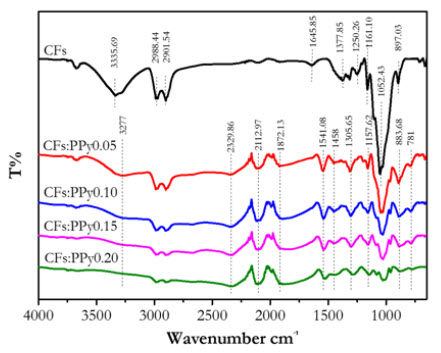Conductive Composite Paper from Cellulose Fiber by in situ Polymerization of Pyrrole
Keywords:
Polypyrrole, Conductive composite materials, in situ SynthesizedAbstract
Currently, conducting polymers such as Polypyrrole (PPy), have been extensively interested due to their
interesting features of conductivity, low-cost fabrication, and stability under ambient conditions and at high temperature. Herein, polypyrrole was polymerized on the surface of cellulose fibers (CFs) by using a sequence of fiber impregnation in FeCl3 solutions and re-dispersion in a pyrrole solution via in situ chemical polymerization of monomer-pyrrole. The structure, morphology, and thermal properties were investigated. The results revealed the uniformly of PPy on the surface of CFs. Moreover, conductivity of 184×10-4 Sꞏcm−1 was obtained from a composites sheet of CFs:PPy with the PPy of 0.20 ml. Also, the decreasing of dielectric and impedance in CFs:PPy composites sheet can be observed as the increasing of CFs:PPy ratio. Chemical polymerization has been very successful in the production of composite materials of conductivity polymers with CFs.
References
Ali, F., Reinert, L., Lévêque, J.-M., Duclaux, L., Muller, F., Saeed, S., & Shah, S. S. (2014). Effect of sonication conditions: solvent, time, temperature and reactor type on the preparation of micron sized vermiculite particles. Ultrasonics sonochemistry, 21(3), 1002-1009. doi: 10.1016/j.ultsonch.2013.10.010
Chougule, M., Dalavi, D., Mali, S., Patil, P., Moholkar, A., Agawane, G., . . . Patil, V. (2012). Novel method for fabrication of room temperature polypyrrole–ZnO nanocomposite NO2 sensor. Measurement, 45(8), 1989-1996. doi: 10.1016/j.measurement.2012.04.023
Du, X., Zhang, Z., Liu, W., & Deng, Y. (2017). Nanocellulose-based conductive materials and their emerging applications in energy devices-
A review. Nano Energy, 35, 299-320. doi:10.1016/j.nanoen.2017.04.001
El Nahrawy, A. M., Haroun, A. A., Hamadneh, I., & Al-Dujaili, A. H. (2017). Conducting cellulose/TiO2 composites by in situ polymerization of pyrrole. Carbohydrate polymers, 168, 182-190. doi:10.1016/j.carbpol.2017.03.066
Fackler, K., Stevanic, J. S., Ters, T., Hinterstoisser, B., Schwanninger, M., & Salmén, L. (2011). FT-IR imaging microscopy to localise and characterise simultaneous and selective whiterot decay within spruce wood cells. Holzforschung, 65(3), 411-420.
Ford, E. N. J., Mendon, S. K., Thames, S. F., & Rawlins, J. W. (2010). X-ray diffraction of cotton treated with neutralized vegetable oilbased
macromolecular crosslinkers. Journal of Engineered Fibers and Fabrics, 5(1), 155892501000500102. doi:10.1177/155892501000500102
Fu, J., Zhang, J., Song, X., Zarrin, H., Tian, X., Qiao, J., ... Chen, Z. (2016). A flexible solid-state electrolyte for wide-scale integration of rechargeable zinc–air batteries. Energy & Environmental Science, 9(2), 663-670. doi:10.1039/c5ee03404c
Hansora, D., Shimpi, N., & Mishra, S. (2015). Graphite to graphene via graphene oxide: an overview on synthesis, properties, and applications. Jom, 67(12), 2855-2868. doi: 10.6084/m9.figshare.1094371
Ho, T. A., Jun, T.-S., & Kim, Y. S. (2013). Material and NH3-sensing properties of polypyrrolecoated tungsten oxide nanofibers. Sensors and
Actuators B: Chemical, 185, 523-529. doi:10.1016/j.snb.2013.05.039
Lay, M., Méndez, J. A., Delgado-Aguilar, M., Bun, K. N., & Vilaseca, F. (2016). Strong and electrically conductive nanopaper from cellulose nanofibers and polypyrrole. Carbohydrate polymers, 152, 361-369. doi:10.1016/j.carbpol.2016.06.102
Li, J., Wang, Y., & Ba, D. (2012). Characterization of semiconductor surface conductivity by using microscopic four-point probe technique.
Physics Procedia, 32, 347-355. doi: 10.1016/j.phpro.2012.03.568
Li, Y., Zhang, H., Ni, S., & Xiao, H. (2018). In situ synthesis of conductive nanocrystal cellulose/polypyrrole composite hydrogel based on semi-interpenetrating network. Materials Letters, 232, 175-178.
Luo, Y.-L., Fan, L.-H., Xu, F., Chen, Y.-S., Zhang, C.-H., & Wei, Q.-B. (2010). Synthesis and characterization of Fe3O4/PPy/P (MAA-co-AAm) trilayered composite microspheres with electric, magnetic and pH response characteristics. Materials Chemistry and Physics, 120(2-3),
-597.
Mahadeva, S. K., & Kim, J. (2011). Enhanced electrical properties of regenerated cellulose by polypyrrole and ionic liquid nanocoating.
Proceedings of the Institution of Mechanical Engineers, Part N: Journal of Nanoengineering and Nanosystems, 225(1), 33-39. doi:10.1177/
Mohanty, A. K., Misra, M., & Drzal, L. (2002). Sustainable bio-composites from renewable resources: opportunities and challenges in the
green materials world. Journal of Polymers and the Environment, 10(1-2), 19-26.
Müller, D., Rambo, C., Recouvreux, D., Porto, L., & Barra, G. (2011). Chemical in situ polymerization of polypyrrole on bacterial cellulose nanofibers. Synthetic Metals, 161(1-2),106-111. doi:10.1016/j.synthmet.2010.11.005
Nakata, M., & Kise, H. (1993). Preparation of Polypyrrole-Poly(vinyl chloride) Composite Films by Interphase Oxidative Polymerization.
Polymer Journal, 25(1), 91-94. doi:10.1295/polymj.25.91
Pleumphon, C., Thiangtham, S., Pechyen, C., Manuspiya, H., & Ummartyotin, S. (2017). Development of conductive bacterial cellulose
composites: An approach to bio-based substrates for solar cells. Journal of Biobased Materials and Bioenergy, 11(4), 321-329.doi:10.1166/
jbmb.2017.1686
Poletto, M., Pistor, V., Zeni, M., & Zattera, A. J. (2011). Crystalline properties and decomposition kinetics of cellulose fibers in wood pulp obtained by two pulping processes. Polymer Degradation and Stability, 96(4), 679-685. doi:10.1016/j.polymdegradstab.2010.12.007
Porjazoska Kujundjiski, A., Chamovska, D., & Grchev, T. (2014). Capacitive properties of polypyrrole/activated carbon composite. Hemijska industrija, 68, 63-63. doi:10.2298/HEMIND140305063P
Raghunathan, S. P., Narayanan, S., Poulose, A. C., & Joseph, R. (2017). Flexible regenerated cellulose/polypyrrole composite films with enhanced dielectric properties. Carbohydrate polymers, 157, 1024-1032. doi:10.1016/j.carbpol.2016.10.065
Rosa, M., Medeiros, E., Malmonge, J., Gregorski, K., Wood, D., Mattoso, L., . . . Imam, S. (2010). Cellulose nanowhiskers from coconut husk fibers: Effect of preparation conditions on their thermal and morphological behavior. Carbohydrate polymers, 81(1), 83-92. doi:10.1016/
j.carbpol.2010.01.059
Ummartyotin, S., & Manuspiya, H. (2015a). A critical review on cellulose: from fundamental to an approach on sensor technology. Renewable and Sustainable Energy Reviews, 41, 402-412. doi: 10.1016/j.rser.2014.08.050
Ummartyotin, S., & Manuspiya, H. (2015b). An overview of feasibilities and challenge of conductive cellulose for rechargeable lithium
based battery. Renewable and Sustainable Energy Reviews, 50, 204-213. doi:10.1016/j.rser.2015.05.014
Wang, S., Lu, A., & Zhang, L. (2016). Recent advances in regenerated cellulose materials. Progress in Polymer Science, 53, 169-206. doi:10.1016/j.progpolymsci.2015.07.003
Xu, F., Yu, J., Tesso, T., Dowell, F., & Wang, D. (2013). Qualitative and quantitative analysis of lignocellulosic biomass using infrared techniques: a mini-review. Applied Energy, 104,801-809. doi:10.1016/j.apenergy.2012.12.019
Zhong, Q., Zhong, J., Hu, B., Hu, Q., Zhou, J., & Wang, Z. L. (2013). A paper-based nanogenerator as a power source and active sensor. Energy & Environmental Science, 6(6), 1779-1784. doi:10.1039/c3ee40592c













